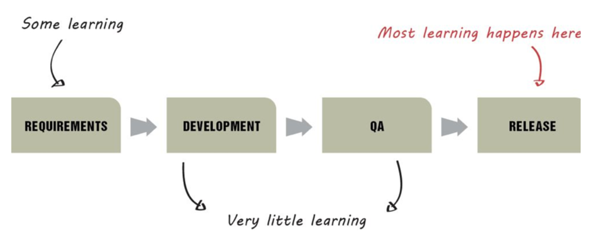September 28, 2018
Digital transformation: why you're getting it wrong
To avoid finding themselves in a tight spot over the medium to long term, increasing numbers of businesses are now beginning the process of digitally transforming themselves, and standing in the way of this process is a simple, basic question: How can you become more agile in your everyday work and management? Discover how we leverage these liberated principles for our own organization at Ferpection.
Seven received ideas about management that you're going to need to dispense with
Here at Ferpection, we have called into question seven received ideas that can prevent you from doing this change. After having trained several teams from major corporate groups about these changes, I can guarantee you that whatever the size of your business, you too will be able to challenge these seven received ideas and implement a style of management that's more agile, more human and more profitable.
You're probably saying to yourself that Ferpection is a startup and that these new ways of operating are not applicable to your organization, which will never be a liberated company. Don't forget, however, that we are the sole ones responsible for setting our own limits. For example, did you know it's possible to pierce a potato with a simple drinking straw? I had the pleasure of carrying out this exercise with Cegos and a team of senior managers at Club Med as a way of showing them that they were capable of going beyond their preconceived notions. So, ready to become agile?
Received idea No. 1 — In order to succeed, you first need a good idea
When I first set up Ferpection, numerous people told me that because I had a good idea in the shape of these tests carried out using a community of users, I was going to be successful. Two years later, the idea still remains the same, yet there are daily challenges involved in ensuring its development, and even around ensuring the actual survival of the company on certain days. In my experience, ninety-nine percent of setting up a business is about the day-to-day process itself, with the idea behind it representing, at best, just one percent.
Examples of this are legion. Recently, LinkedIn was sold to Microsoft for $27 billion, yet Viadeo ended up having to close down — the same underlying idea, but clearly not the same execution. And if you're asking yourself to what extent LinkedIn was at an advantage due to it being American, don't forget that we also have runaway worldwide successes such as Blablacar and Criteo.
The problem, in a large business, is that projects often get held up at the idea stage — which provides little in the way of value — for months on end, due to the many steering groups and executive committees involved.
To combat this phenomenon, here at Ferpection we've decided to test the value of our ideas with our users as rapidly as possible. How? That's the focus of our second received idea.
Received idea No. 2 — You can only launch finished products
This is the perfect example of a counterintuitive received idea: How can you bring something that doesn't actually exist to the market? Yet everyday startups are doing exactly this, and not just the smallest ones: examples include Deliveroo, Stripe and Airbnb. They're prepared to take the risk because they want to verify that their innovation has value to offer (translation: that it sells). In fact, why waste months developing a solution when it's possible to find out straight away if it will sell? The gains in productivity are enormous. The graphic below, which comes from Lean Startup, illustrates this:
To quickly find out whether what you're working on will make you "rich and famous" or not, you can either:
-
reduce the number of phases prior to the initial launch
-
get rid of them entirely
-
carry out testing as the development phase progresses!
To save time, it is particularly important to focus on whatever it is that will get your customers interested and enthusiastic, and not on how you yourself are going to get them interested and enthusiastic. When the team that founded Airbnb noticed that the quality of the photos provide by their "hosts" was not up to standard, they didn't try developing a super software solution: They jumped on the plane so they could go off and take better photos themselves and thus find out if it was possible to improve sales that way. It was only after first checking what impact these photos would have that they put in place a more technical solution.
Received idea No. 3 — A year equates to 12 months
To speed things up, you need to break out of the rigid frameworks that serve to slow us down. As Parkinson's law shows, all work expands to fill the time allocated to it. If you allocate less time to a task, therefore, you should be able to still complete it all by gaining speed. The idea isn't to drive yourself at a frantic rate, but rather the contrary. It's simply a matter of speeding things up by reducing the timescale.
Here at Ferpection, therefore, we've decided that a year consists of just three months, which thus means we're now in our 16th year. Except in our reports and dealings with officialdom, we apply this three-month year principle in our everyday activities in order to gain the following benefits:
-
Give ourselves the freedom to develop and evolve our strategy and plans as quickly as possible.
-
Follow fewer indicators and lists of actions to take, but follow them better.
-
Engage and inspire the team on an annual basis (i.e. every three months, if you've been following).
-
Limit investment in strategic operations to the most appropriate and workable minimum. Our entire process — which we refer to as our Lean Ceremony — takes one and a half days, which includes half a day with the whole team in an informal setting.
There are many other ways to shorten timescales, such as, for example, having quick 15 minute review meetings and full meetings lasting only 45 minutes, etc. What can you do in your business to break out of the usual rigid framework?
Received idea No. 4 — A report is a table (a complex one)
I have something to admit. I've never been a fan of the tables used in reports, with all those numerous indicators that you end up getting lost in and that make it a struggle to identify the corrective actions to take. For me, a good report should always:
-
Be easy to understand.
-
Motivate teams to surpass themselves.
-
Provide clear indications about what needs to be improved.
At Ferpection, we use just two indicators: our clients' satisfaction levels and our turnover, so that we know whether we're going to be able to pay our bills at the end of the month.
Let's concentrate on turnover, as it's such a deep subject that I'd definitely be able to write a satisfactory article just on this topic alone. When it comes to turnover, we measure our progress using Lego blocks, with each piece representing €100. This gets everyone interested in the subject, including the developers, because everyone wants us to generate sales and everyone can see each week how our business is progressing.
Received idea No. 5 — Decisions need to be considered and weighed for a long time
Fifty percent of the decisions we make each day turn out to be bad ones. Difficult to believe? Perhaps, but nevertheless, eminent scientists — some of whom have been awarded Nobel Prizes, such as Daniel Kahneman — have demonstrated to what extent the functioning of our brains can lead us to make bad decisions. If you're interested in this subject, a good place to start is by reading Dan Gilbert or Paul C. Nutt.
To get back to the topic in question, and knowing that we all make plenty of bad decisions, it therefore makes sense to make them quickly and give yourself enough time to adjust and fine tune them if necessary.
Few decisions really merit having lots of meetings and steering group/executive committee time devoted to them. Let's consider the case of an apparently complicated decision: setting the turnover target for the coming year. This decision is rendered complicated by the fact that we cannot predict the future and its contingencies. It's a decision that needs to be made because the sales staff need an ambitious target to aim for and surpass! In fact, what counts more is not that the figure is precise—it's difficult to rationally define an exact figure–but the fact that it's made.
I therefore submitted two Lego models (see the preceding received idea) for 2017: the Ghostbusters headquarters and the Death Star from Star Wars. The number of pieces these two models contain corresponds to what would be an achievable and ambitious stage of development for Ferpection to reach, so I was comfortable with these two turnover "targets". However, I didn't communicate the details to the team, which set itself the ambition of constructing the Death Star rather than achieving an abstract figure. Result: a quick decision (agile!), and one in which everyone feels involved, no matter whether they're members of the sales force or not.
Received idea No. 6 — That's my chair
The existence of territories in the world of work is one of the factors that undermine the process of digital transformation. These territories are many in number: offices, budgets, teams, responsibilities, parking places, etc. If giving up a budget or a team is proving difficult to accept, you can begin by defusing the situation at a basic level, at a physical level even.
For example, we have adopted the habit of not having set, assigned workplaces in the office. This has been done to avoid three pitfalls:
-
the boss getting the best places,
-
a specific routine becoming established, surreptitiously
-
the formation of cliques.
Paradoxically, I encountered quite a bit of initial resistance to this from my team, who couldn't really see the benefit of changing chairs everyday compared to the comfort of having a specific workplace (completely relative comfort that is, given that all the chairs are the same). Finally, and by carefully explaining things and setting the example whilst at the same time allowing everyone the freedom to make their own choice, the entire team ended up adopting the practice of changing chairs each day, and they're all the better for it!
Received idea No. 7 — Mistakes are not permitted
This point caused quite a lot of debate during the training sessions about digital transformation and management I was able to organize and deliver. Many operational and middle managers feel ready to take risks but can see that there are those above them who are not willing to accept failure, despite all the pretty speeches about innovation and entrepreneurship.
Coca-Cola, the last company I worked for before becoming an entrepreneur, had an innovative approach to this issue. It consisted of guaranteeing that all projects would involve an obligatory experimentation component equating to 10% of the total time/budget allocated to the project.
More broadly, if you have someone above you who does not want to take risks, you will need to educate and enlighten them:
-
Remind them that it's now company policy to experiment.
-
Reach an agreement to carry out "small", easy to manage tests to begin with.
-
Estimate the cost of making a mistake. What risk does failure pose to the company? It's one thing to accept the possibility of getting things wrong, but it's another entirely to write a blank check. Reaching an agreement about the level of risk in advance can help you progress to the decision stage.
-
You could even simulate a failure scenario (or pre-mortem) with the team as a way of anticipating these risks and seeing how you might manage them. Because it involves your management, this a very reassuring approach to adopt.
-
Get official support with respect to the risk so you don't find yourself stopped from going any further if failure does occur. You should communicate in advance about the experiment carried out, the risks involved and what you hope to learn.
-
Celebrate failure as much as success: What did you learn from your failure? Will this enable you to bounce back and try a new and more promising approach?
In conclusion, digital transformation is primarily a quest for velocity, and this is achieved by rejecting everything that no longer works in businesses: excessively long meetings, indecision and territorial battles.
Though startups are not necessarily exempt from management difficulties, they experiment enough to provide some interesting avenues for large companies to explore.
And it's in fact on this basis that Ferpection provides help and support to organizations and trains businesses in co-creation, digital transformation and design sprinting.
All articles from the category: Culture | RSS





